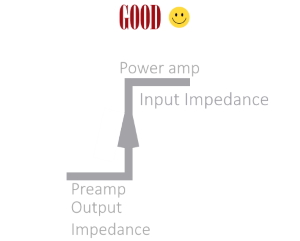
First, we want to let you know that you don’t need to worry about impedance questions if you choose a Backert Labs preamp.
So the rest of this discussion is for information only – you do not need to worry about this if you have one of our preamps.
We aren’t going to bore you with a discussion of “What is impedance?” This article is meant to give you the rule you need, and that’s all.
The Rule
Think of your music as if it’s traveling a path. That path starts with your music source (for example, a CD player), and ends with your speakers.
In general terms, each step of that journey (from music source to preamp, from preamp to power amp….) should involve a large step UP in terms of impedance.
In other words, if you start with a CD player, the output impedance of that player should be much lower than the input impedance of the next component in the chain.
The same is true as the music signal continues on its journey.
So, next step: as it passes from a preamp to a power amp, the output impedance of the preamp should be much less than the input impedance of the power amp.
An illustration:

How Much Higher?
As a general “back of the envelope” matter, the jump in impedance from the output of one device to the input of the next device should be 10 times or more.
Examples:
- If a CD player’s output impedance is 200 ohms, you want at least 2,000 ohms (10 times higher) as the input impedance of the next device in the chain.
- If a preamp has a 1,000-ohm output impedance, you want the power amp to have an input impedance of at least 10,000 ohms (10 times higher).
Luckily, most preamps have less than a 1,000-ohm output impedance, and most power amps have 10,000-ohm input impedance or higher (although there are exceptions all over the place).
Backert Labs preamps have 75 ohms output impedance – very low – this is why you don’t need to worry about impedance matters if you own a Backert Labs.
What’s the Harm? None, Really
If you end up with substantially less than a 10-times increase in impedance from one component to the next, you won’t hurt anything. The usual result is just, a lack of bass.
We hope you found this helpful. If you have questions, you can always contact us at:
![]()

